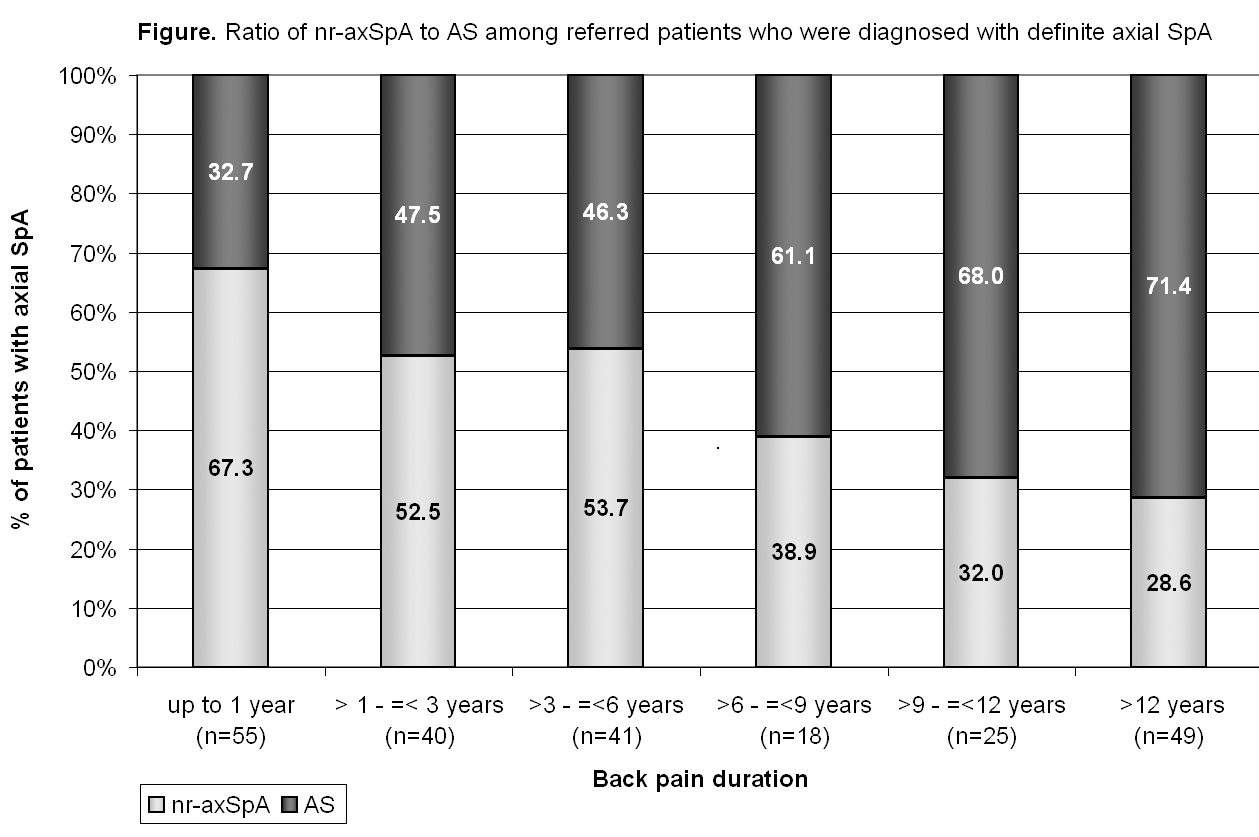Session Information
Session Type: Abstract Submissions (ACR)
Background/Purpose:
Non-radiographic axial spondyloarthritis (nr-axSpA) and radiographic axial SpA (=ankylosing spondylitis – AS) are considered currently as two stages of axial SpA. We reported recently that about 12% of the patients with non-radiographic axial SpA progress in AS over 2 years [1]. Although it can be expected that in the first years after back pain onset non-radiographic (without definite sacroiliitis on the x-ray) SpA is more likely to see than established AS, their frequencies and their ratio in relation to back pain duration at the referral time point is not known.
This study was aimed at investigating of the frequencies of non-radiographic axial SpA (nr-axSpA) and ankylosing spondylitis (AS) diagnoses and their ratios in relation to symptom duration in patients referred because of chronic back pain and suspicion of axial SpA.
Methods:
In this monocenter study performed in Berlin [2] orthopaedists and primary care physicians were requested to refer patients with chronic low back pain (duration >3 months) and onset of back pain before <45 years of age to a SpA-specialized rheumatology outpatient clinic for further diagnostic investigation if at least one of the following screening parameters was present: 1) inflammatory back pain, 2) positive HLA-B27, and 3) sacroiliitis detected by imaging. The final diagnosis was made according to the opinion of rheumatologist.
Results:
A diagnosis of definite axial SpA was made in 43.7% of the referred patients (n = 522). Axial SpA was diagnosed in a similar percentage of about 50% if back pain duration was <9 years but decreased to 36% if symptom duration was >9 years. Nr-axSpA represented the majority of patient (67.3%) only if duration of back pain was 1 year and less at the time of referral. Between 1 and 6 years of back pain duration the probability of nr-axSpA and AS was nearly equal (1-3 years: 52.5% and 47.5%, respectively; 3-6 years: 53.7% and 46.3%, respectively). In patients with back pain duration of 6-9 years, AS was more likely (61.1%) to be diagnosed than nr-axSpA (38.9%), and this increased further over time – figure.
Conclusion:
Non-radiographic axial SpA represents an important diagnosis in the structure of reasons of back pain, especially in patients with recent symptom onset.
References: 1. Ann Rheum Dis 2011;70:1369-74. 2. Ann Rheum Dis 2007;66:1479-84.
Disclosure:
D. Poddubnyy,
None;
H. Brandt,
None;
J. Vahldiek,
None;
I. Spiller,
None;
I. H. Song,
None;
M. Rudwaleit,
None;
J. Sieper,
None.
« Back to 2012 ACR/ARHP Annual Meeting
ACR Meeting Abstracts - https://acrabstracts.org/abstract/the-frequency-of-non-radiographic-axial-spondyloarthritis-in-relation-to-symptom-duration-in-patients-referred-because-of-chronic-back-pain-results-from-the-berlin-early-spondyloarthritis-clinic/

